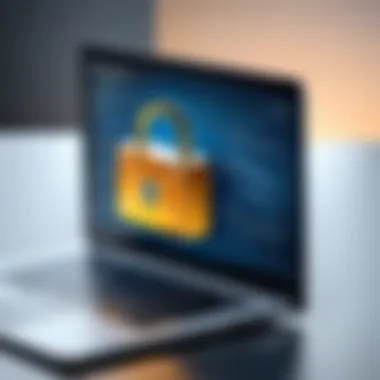Secure Your Email Messages with Best Practices for Privacy and Confidentiality


Technological Research Overview
As the digital landscape continues to evolve, the importance of securing email messages remains paramount. Recent technological innovations in encryption methods and authentication protocols have significantly enhanced privacy and confidentiality in email communications. These advancements have a direct impact on business operations, enabling organizations to exchange sensitive information securely. Looking ahead, future technological trends indicate a continued focus on strengthening email security to combat evolving cyber threats.
Data Analytics in Business
Within the realm of email security, data analytics plays a crucial role in identifying potential vulnerabilities and threats. Understanding the importance of data analytics in safeguarding email communications is key to implementing effective security measures. Leveraging advanced tools for data analysis allows businesses to detect anomalies and unusual activities that may pose risks to confidentiality. Through case studies on data-driven decisions, the significance of proactive email security measures becomes evident.
Cybersecurity Insights
A comprehensive email security strategy must encompass insights into the ever-changing threat landscape. Conducting a thorough threat landscape analysis enables organizations to stay ahead of potential risks and vulnerabilities. Implementing best practices for cybersecurity, such as regular system updates and employee training, is essential in mitigating email security breaches. Moreover, maintaining regulatory compliance in cybersecurity ensures adherence to data protection laws and standards, reinforcing the integrity of email communications.
Artificial Intelligence Applications
Artificial intelligence (AI) is revolutionizing email security through business automation and predictive analytics. By integrating AI algorithms and applications, organizations can enhance their ability to detect and respond to email threats in real-time. Consideration of ethical implications in AI development is crucial to ensuring responsible and transparent use of AI technologies in email security. As AI continues to advance, its applications in strengthening email privacy and confidentiality are expected to grow.
Industry-Specific Research
Email security measures vary across industries, with specific research focusing on tailored solutions for various sectors. In the finance sector, technology research emphasizes secure email communication to protect financial transactions and sensitive client data. Healthcare technological advancements prioritize robust email encryption to safeguard patient information and adhere to strict privacy regulations. Similarly, the retail industry implements email security solutions to protect customer data and prevent unauthorized access. Industry-specific research underscores the importance of customizing email security protocols to address unique challenges faced by each sector.
Introduction
Email, being a primary mode of communication in the modern era, serves as a repository of sensitive information ranging from personal details to confidential business data. Without adequate security measures in place, the risk of unauthorized access, data breaches, and information leakage significantly amplifies. Moreover, in a regulatory environment where data privacy laws such as GDPR and HIPAA are stringent, ensuring the protection of email content is not just a best practice but a legal requirement that organizations must adhere to.
Furthermore, with the rise of sophisticated cyber threats such as phishing scams, email spoofing, and malware attacks, the need for robust email security protocols is more pronounced than ever. By establishing a comprehensive understanding of email security fundamentals, individuals and organizations can fortify their defenses, mitigate risks, and maintain the integrity and confidentiality of their communication channels.
In essence, the Introduction section sets the stage for a detailed exploration of encryption techniques, authentication protocols, server security best practices, training initiatives, monitoring strategies, and incident response protocols that collectively contribute to a holistic approach towards securing email messages effectively. By shedding light on the importance and implications of email security, this section aims to provide readers with a strategic outlook on mitigating vulnerabilities and safeguarding the privacy of their digital correspondence.
Understanding Email Security


Email security is a critical aspect that cannot be overlooked in today's digital landscape. In this comprehensive guide on securing email messages, we delve into the intricate details that govern the safeguarding of sensitive information in email communications. Understanding email security involves implementing robust measures to ensure privacy and confidentiality.
Importance of Securing Email Messages
When discussing the importance of securing email messages, it is crucial to highlight the need to protect sensitive information from unauthorized access and breaches. Securing email messages helps in maintaining the integrity and confidentiality of communication exchanges, which is imperative for businesses, individuals, and organizations. By encrypting emails and implementing authentication protocols, the risk of data leaks and cyber-attacks is significantly reduced.
Risks Associated with Unsecured Emails
Unsecured emails pose a multitude of risks, ranging from data interception to phishing attacks. When emails are sent without encryption or proper authentication, they are vulnerable to interception by malicious actors, leading to potential data breaches and privacy violations. Moreover, unsecured emails are prone to tampering and spoofing, which can result in identity theft and financial losses. Understanding these risks underscores the importance of implementing robust security measures.
Compliance Requirements for Email Security
In today's regulatory environment, compliance with email security standards is non-negotiable. Various regulations such as GDPR and HIPAA require organizations to ensure the confidentiality and integrity of email communications. Compliance requirements mandate the use of encryption, digital signatures, and secure server configurations to protect sensitive data. By adhering to these standards, organizations can mitigate legal risks and demonstrate a commitment to safeguarding customer information.
Implementing Encryption Techniques
In the realm of email security, implementing encryption techniques stands out as a pivotal step towards fortifying the confidentiality and integrity of digital correspondences. Email encryption encapsulates information in a cryptographic envelope, rendering it undecipherable to unauthorized entities. The encryption process translates the content of messages into a code that only the intended recipient possessing the decryption key can access, thwarting interception attempts by malicious actors. By adopting encryption mechanisms, organizations and individuals can mitigate the risks of data breaches and uphold the privacy of their sensitive information.
Overview of Encryption in Email Communication
The landscape of encryption in email communication encompasses a diverse array of methodologies aimed at enhancing the security posture of electronic correspondences. Encryption serves as a shield that safeguards the contents of emails from unauthorized access during transit or storage. It operates on the premise of leveraging complex algorithms to encode messages, ensuring that only designated parties can unravel the encrypted data. With encryption, the narrative of email security evolves towards a realm of heightened protection, strengthening the digital barriers against cyber intrusions.
End-to-End Encryption
End-to-end encryption represents a sophisticated approach to securing email communications by encrypting messages from the sender's device until they reach the recipient's inbox. This form of encryption ensures that intermediaries, including email service providers, cannot decipher the content of emails traversing their platforms. Each message remains obscured throughout its journey, unveiling its actual content solely to the sender and recipient. End-to-end encryption serves as a cornerstone in safeguarding the confidentiality of emails in a technological landscape riddled with potential vulnerabilities.
PGP Encryption for Email Messages
Pretty Good Privacy (PGP) encryption emerges as a stalwart encryption mechanism for email messages, empowering users to protect their communications with robust cryptographic protocols. PGP encryption hinges on a public-private key pair system, where the sender encrypts the message using the recipient's public key, which can only be decrypted with the corresponding private key. This asymmetric encryption methodology fortifies the security of email communications, establishing a formidable barrier against unauthorized interception and decryption attempts.


SMIME Protocol for Secure Email Communication
SecureMultipurpose Internet Mail Extensions (SMIME) protocol represents an instrumental framework for facilitating secure email communication through digital signatures and encryption. SMIME integrates digital certificates to validate the identities of email senders and recipients, ensuring the authenticity of messages exchanged. By incorporating SMIME into email systems, organizations elevate the trustworthiness and integrity of their correspondences, assuring stakeholders of the secure nature of their interactions.
Ensuring Authentication and Verification
In the realm of securing email messages, authentication and verification play a pivotal role in ensuring the integrity and legitimacy of communications. When considering the topic of ensuring authentication and verification within the context of this exhaustive guide to email security, one must delve into the specific elements that contribute to fortifying the trustworthiness of email exchanges. By focusing on digital signatures, DMARC protocols, SPF, and DKIM mechanisms, this section elucidates how these factors collectively bolster the security posture of email communications.
Digital Signatures to Authenticate Email Senders
Digital signatures serve as a critical aspect of email authentication, serving the purpose of verifying the sender's identity and guaranteeing the message's integrity. Within the spectrum of email security, digital signatures add a layer of assurance by encrypting the sender's identity using cryptographic techniques. By authenticating the origin of the email, recipients can ascertain that the message has not been tampered with and indeed emanates from the claimed sender. This authentication mechanism stands as a robust defense against identity impersonation and phishing attacks, ensuring a level of trustworthiness in email interactions.
DMARC Protocol for Domain Authentication
DMARC (Domain-based Message Authentication, Reporting, and Conformance) protocol stands as a cornerstone in domain authentication within email communications. By leveraging this protocol, organizations can establish policies that determine how an email receiver should handle messages that fail authentication checks. DMARC works hand-in-hand with SPF and DKIM to validate emails, reduce instances of domain spoofing, and enhance overall email security. Through specifying actions for unauthenticated emails, organizations can mitigate phishing threats and safeguard their domain reputation.
Implementing SPF and DKIM for Email Verification
Sender Policy Framework (SPF) and Domain Keys Identified Mail (DKIM) are integral components in authenticating the sending domain and validating email integrity. SPF enables domain owners to define which IP addresses are authorized to send emails, thereby preventing spoofing and unauthorized usage of their domain name. On the other hand, DKIM adds a digital signature to the email header, allowing receivers to verify that the email content has not been altered during transit. Together, SPF and DKIM fortify email verification processes, ensuring that only legitimate emails from verified senders reach their intended recipients.
Securing Email Servers
In this crucial section of the article, we will delve into the vital importance of Securing Email Servers within the broader context of safeguarding email communications. Securing email servers is fundamental to ensuring the integrity and confidentiality of sensitive information transmitted through emails. By implementing robust security measures on email servers, organizations can mitigate the risks of unauthorized access, data breaches, and interception of confidential data.
Best Practices for Secure Email Server Configuration
When it comes to secure email server configuration, organizations must adhere to a stringent set of best practices to enhance the overall security posture of their email infrastructure. This involves establishing encryption protocols, enforcing access controls, regularly updating security patches, and implementing multi-factor authentication mechanisms. Furthermore, organizations should conduct regular security audits and vulnerability assessments to identify and address any potential security gaps in their email server configuration.
Protecting Against Email Spoofing and Phishing Attacks


Email spoofing and phishing attacks continue to pose significant threats to email security, making it imperative for organizations to proactively protect against such malicious activities. To mitigate the risks of email spoofing and phishing, organizations should implement email authentication protocols such as SPF (Sender Policy Framework) and DKIM (Domain Keys Identified Mail). Additionally, user education and awareness programs are essential to empower employees to recognize and report suspicious emails effectively.
Email Firewall and Intrusion Detection Systems
Email firewall and intrusion detection systems play a crucial role in fortifying the security of email servers against a wide range of cyber threats, including malware, ransomware, and phishing attempts. Organizations can deploy robust email filtering solutions that inspect incoming and outgoing emails for malicious content and potential security vulnerabilities. Intrusion detection systems help in detecting and responding to suspicious activities on the email server, providing real-time alerts and notifications to security teams for prompt mitigation actions.
Training and Awareness Programs
In the realm of email security, Training and Awareness Programs are indispensable components that play a pivotal role in fortifying organizational defenses against potential threats. By educating employees on email security best practices, companies can mitigate risks associated with cyber-attacks and data breaches. These programs serve as proactive measures to enhance awareness, knowledge, and vigilance among staff members regarding the importance of safeguarding sensitive information. Implementing Training and Awareness Programs not only fosters a security-conscious culture within the organization but also empowers employees to recognize and respond effectively to email-related security incidents.
Educating Employees on Email Security Best Practices
Educating employees on email security best practices involves instilling a comprehensive understanding of the latest cybersecurity threats, phishing techniques, and social engineering tactics. By educating staff members on how to identify malicious emails, suspicious links, and deceptive content, organizations can significantly reduce the likelihood of falling victim to cyber-attacks. Training sessions should cover topics such as password management, email encryption, secure file sharing, and the importance of regular software updates. By cultivating a strong knowledge base and promoting a security-centric mindset among employees, organizations can bolster their defenses against evolving cyber threats and unauthorized access attempts.
Conducting Phishing Simulations and Cybersecurity Training
Conducting phishing simulations and cybersecurity training exercises form an integral part of email security awareness initiatives. By simulating real-life phishing scenarios, organizations can gauge employees' susceptibility to email scams and assess their ability to discern fraudulent attempts. These simulations provide valuable insights into employee behavior and highlight areas that require further training and reinforcement. Cybersecurity training should be ongoing, interactive, and tailored to address the specific needs and challenges faced by employees. By fostering a culture of continuous learning and vigilance, organizations can empower their workforce to stay vigilant against phishing attacks and other email security threats.
Monitoring and Incident Response
In the realm of securing email messages, Monitoring and Incident Response play a pivotal role in maintaining the integrity and confidentiality of communications. Monitoring ensures continuous oversight of email activities, allowing for the swift identification of any suspicious or unauthorized behavior. It serves as a proactive defense mechanism, enabling organizations to detect anomalies and potential threats before they escalate. Incident Response, on the other hand, is the reactive counterpart that dictates how organizations respond to security breaches or email-related incidents. Developing a robust Incident Response Plan is essential for mitigating the impact of security breaches and minimizing potential damages. By outlining clear protocols and procedures for addressing security incidents, organizations can effectively manage crises and safeguard their sensitive information.
Continuous Monitoring of Email Activities
Continuous Monitoring of Email Activities involves the constant surveillance of email communications to detect any irregularities or potential security risks. Through automated monitoring tools and real-time analysis, organizations can actively track incoming and outgoing emails, monitor access logs, and identify any suspicious patterns or behavior. Continuous monitoring enables organizations to maintain a proactive stance against evolving security threats, allowing for immediate intervention in the event of unauthorized access or data breach attempts. By analyzing email traffic trends and user behavior, organizations can streamline their security protocols and enhance their defenses against email-based attacks.
Developing an Email Incident Response Plan
Developing an Email Incident Response Plan is critical for establishing a structured approach to addressing security incidents and breaches. This plan outlines the step-by-step procedures to be followed in the event of a security breach or suspected email compromise. Key elements of an effective Incident Response Plan include designated response teams, communication protocols, escalation procedures, containment strategies, forensic analysis guidelines, and recovery measures. By proactively developing and regularly testing an Incident Response Plan, organizations can minimize response times, reduce disruption to operations, and mitigate potential financial and reputational damages in the face of security incidents.
Conclusion
One of the key elements emphasized in this article is the implementation of robust encryption techniques to secure email messages effectively. Encryption plays a vital role in safeguarding the contents of emails from unauthorized access, providing an additional layer of protection against interception and tampering. Through encryption, sensitive data can be shielded from prying eyes, maintaining confidentiality and integrity throughout the communication process.
Moreover, the focus on authentication and verification protocols is instrumental in verifying the legitimacy of email senders and detecting potential threats such as domain spoofing and phishing attempts. By employing digital signatures, DMARC, SPF, and DKIM protocols, users can authenticate the source of emails and verify their integrity, reducing the risk of falling victim to malicious attacks.
Furthermore, securing email servers through best practices in configuration, protection against spoofing and phishing attacks, as well as the deployment of email firewall and intrusion detection systems, is indispensable in fortifying the overall email security posture. By implementing these measures, organizations can create a robust defense mechanism that shields against external threats and internal vulnerabilities.







